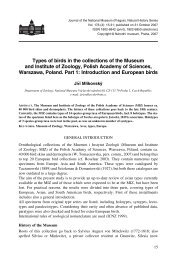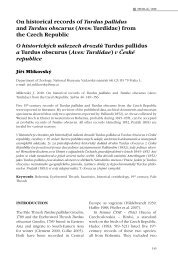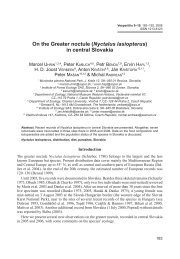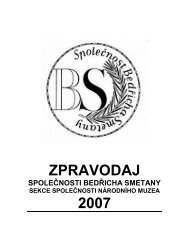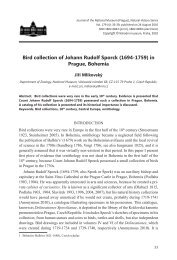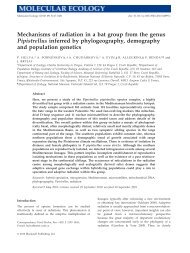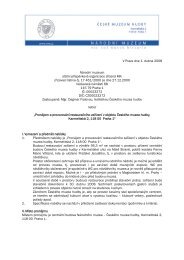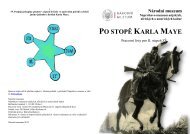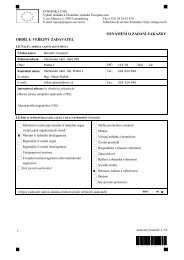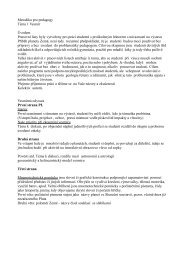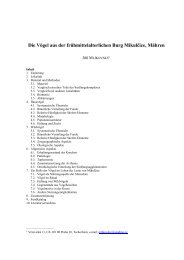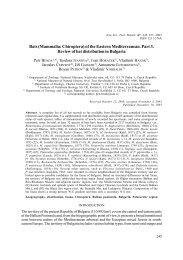Records of the Purple Swamphen (Porphyrio ... - Národní muzeum
Records of the Purple Swamphen (Porphyrio ... - Národní muzeum
Records of the Purple Swamphen (Porphyrio ... - Národní muzeum
You also want an ePaper? Increase the reach of your titles
YUMPU automatically turns print PDFs into web optimized ePapers that Google loves.
SYLVIA 47 / 2011(MZMB 30230 for <strong>the</strong> mount, and MZMB28082 for partial skeleton, includingsternum, both coracoids, cranial ends <strong>of</strong>both scapulae, and clavicula). The entriesin Museum catalogues and inscriptionson labels are confusing. The InventoryCatalogue tells that <strong>the</strong> bird originatesfrom Znojmo from 1967. A label attachedto <strong>the</strong> partial skeleton gives Jaroslaviceas <strong>the</strong> place <strong>of</strong> <strong>the</strong> bird’s origin anda date “21 August 1967”, without explainingwhat <strong>the</strong> date means. The AccessionCatalogue tells that <strong>the</strong> bird was purchasedfrom J. Sýkora at “Jaroslaviceu Znojma” on 21 August 1957.Most probably, this was a captive birdpurchased by <strong>the</strong> MZMB on 21 August1957 from <strong>the</strong> bird-keeper J. Sýkora, who<strong>the</strong>n lived in <strong>the</strong> village <strong>of</strong> Jaroslavicenear Znojmo (H. Sutorová, pers. communication,2009 and 2010).DISCUSSIONTaxonomic identityThe 1884 and 1957 specimens belongto <strong>the</strong> nominotypical “porphyrio” type,while <strong>the</strong> 1905 and 1910 specimensbelong to <strong>the</strong> “madagascariensis” type.Some authors preferred to distinguish<strong>the</strong> Egyptian population <strong>of</strong> “madagascariensis”under <strong>the</strong> name aegyptiacusHeuglin (1856: 65), but <strong>the</strong> differencesare no more considered diagnostic andaegyptiacus is thus currently treatedas inseparable from madagascariensis(e.g. Keith 1986, Sangster 1998, Taylor1998). On <strong>the</strong> o<strong>the</strong>r hand, <strong>the</strong> differencesbetween individual subspecies (or subspeciesgroups) traditionally included in<strong>the</strong> broadly understood P. porpyrio arenow treated as separate species by someauthors (e.g. Trewick 1997, Sangster1998). I follow here Dickinson (2003)in treating P. porphyrio as a polytypicspecies until more data are available.Patterns <strong>of</strong> occurrence in CentralEuropeI limited <strong>the</strong> following analysis to <strong>the</strong>period 1851–1950, which covers allCzech <strong>Porphyrio</strong> records (excluding <strong>the</strong>invalid record from 1957 – see above).Most <strong>Purple</strong> <strong>Swamphen</strong>s were recordedin <strong>the</strong> western and central parts <strong>of</strong>Central Europe (Fig. 1), which mightreflect bird-keeping activities and/or intensity<strong>of</strong> bird-recording in <strong>the</strong> wild. Thenearest breeding grounds <strong>of</strong> <strong>the</strong> nominotypicalporphyrio were in <strong>the</strong> IberianPeninsula (Sánchez Lafuente et al. 1992,Mañez 1997), those <strong>of</strong> <strong>the</strong> madagascariensistype in <strong>the</strong> Nile Delta in Egypt(Goodman & Meininger 1989).All birds were recorded from June toDecember, but mostly toward <strong>the</strong> end <strong>of</strong><strong>the</strong> year (Fig. 2). Three records withoutexact data available were all said to comefrom autumn (Spitzenberger 1973),which agrees with <strong>the</strong> above pattern.The frequency <strong>of</strong> occurrence <strong>of</strong> <strong>Purple</strong><strong>Swamphen</strong>s and <strong>the</strong>ir forms seems tovary over decades (Fig. 3). Although <strong>the</strong>overall number <strong>of</strong> records is small, <strong>the</strong>statistics revealed two peaks <strong>of</strong> occurrence:one centered at 1871–1880 and<strong>the</strong> o<strong>the</strong>r at 1901–1910. It is notable thatonly <strong>the</strong> nominotypical porphyrio wererecorded during <strong>the</strong> first peak, whileonly madagascariensis were recordedduring <strong>the</strong> second peak.Of <strong>the</strong> thirteen Central Europeanrecords from 1851–1950, <strong>the</strong> Hungarianrecord <strong>of</strong> 1913 (Fig. 1, no. 11) and <strong>the</strong>three German records <strong>of</strong> 1909 (Fig. 1,no. 7–9) were documented as escapees(Hagen 1910, Keve-Kleiner 1943,Spitzenberger 1973).Vagrants vs. escapeesWild <strong>Purple</strong> <strong>Swamphen</strong>s are mostly sedentary,but may leave <strong>the</strong>ir breedinggrounds if <strong>the</strong> swamps dry out or freeze(Taylor 1998). On <strong>the</strong> o<strong>the</strong>r hand, like125
Mlíkovský J. / <strong>Purple</strong> <strong>Swamphen</strong> in <strong>the</strong> Czech RepublicFig. 1. <strong>Records</strong> <strong>of</strong> <strong>the</strong> <strong>Purple</strong> <strong>Swamphen</strong> in Central Europe in 1851–1950, with a historicalrecord from Melchingen. • P. p. porphyrio ● P. p. madagascariensis, ▲ unknown form. 1 –Melchingen (1788), 2 – Bad Segeberg (1862), 3 – Jezioro Dąbie (1875), 4 – Völkermarkt (1879),5 – Nové Hrady (1884), 6 – Žehuňský pond (1905), 7 – Dümmerhütte (1909), 8 – Böbs (1909),9 – Glücksburg (1909), 10 – Nesyt pond (1910), 11 – Harta (1913), 12 – Rendsburg (1923), 13 –Heiligenhafen (1923), 14 – Neckartailfingen (1936). Czech records are from this paper, o<strong>the</strong>rdata from Spitzenberger (1973). See text for explanation.Obr. 1. Nálezy slípky modré ve střední Evropě v letech 1851–1950, doplněné o historický nálezz Melchingenu. • P. p. porphyrio ● P. p. madagascariensis, ▲ neznámá forma. 1 – Melchingen(1788), 2 – Bad Segeberg (1862), 3 – Jezioro Dąbie (1875), 4 – Völkermarkt (1879), 5 – NovéHrady (1884), 6 – Žehuňský pond (1905), 7 – Dümmerhütte (1909), 8 – Böbs (1909), 9 –Glücksburg (1909), 10 – Nesyt pond (1910), 11 – Harta (1913), 12 – Rendsburg (1923), 13 –Heiligenhafen (1923), 14 – Neckartailfingen (1936). České nálezy jsou z této práce, ostatní zeSpitzenberger (1973). Viz text pro vysvětlení.many members <strong>of</strong> <strong>the</strong> family Rallidae,individual <strong>Purple</strong> <strong>Swamphen</strong>s are ableto cross large distances and <strong>the</strong>ir occurrenceas vagrants far from <strong>the</strong>ir breedinggrounds cannot be excluded.Due to <strong>the</strong>ir limited distribution in <strong>the</strong>western Mediterranean (nominotypicalporphyrio) and Egypt (madagascariensis)in <strong>the</strong> western Palearctic, it is possibleto expect that porphyrio would reachCentral Europe from <strong>the</strong> southwest viaFrance, while madagascariensis from<strong>the</strong> sou<strong>the</strong>ast via <strong>the</strong> Balkans and that<strong>the</strong> respective records would be concentratedalong <strong>the</strong>se potential migrationroutes. However, <strong>the</strong> geographicdistribution <strong>of</strong> <strong>the</strong>se records does notsupport this scenario (Fig. 1).<strong>Purple</strong> <strong>Swamphen</strong>s are easily heldand bred in captivity and were favoritepets in Europe at least since <strong>the</strong> mid 19 thcentury. Brehm (1867: 558) noted (mytranslation): “They are frequently andin large numbers <strong>of</strong>fered for sale on <strong>the</strong>European animal market, so that everybodyinterested can get <strong>the</strong>m. I can126
SYLVIA 47 / 2011number <strong>of</strong> records / počet záznamů654321porphyriomadagascariensis01851-18601861-18701871-18801881-18901891-19001901-19101911-19201921-19301931-19401941-1950Decade / dekádaFig. 2. Seasonal distribution <strong>of</strong> <strong>Purple</strong> <strong>Swamphen</strong> records in Central Europe in 1851–1950. Czechrecords are from this paper, o<strong>the</strong>r data from Spitzenberger (1973). See text for explanation.Obr. 2. Rozložení nálezů slípky modré ve střední Evropě z let 1851–1950 v průběhu roku. Českénálezy jsou z této práce, ostatní ze Spitzenberger (1973). Viz text pro vysvětlení.3number <strong>of</strong> records / počet záznamů21porphyriomadagascariensis0Jan Feb Mar Apr May Jun Jul Aug Sep Oct Nov Decmonth / měsícFig. 3. Frequency <strong>of</strong> records (specimens collected or observed) <strong>of</strong> <strong>Purple</strong> <strong>Swamphen</strong> in CentralEurope during 1851–1950. Czech records are from this paper, o<strong>the</strong>r data from Spitzenberger(1973). See text for explanation.Obr. 3. Četnost výskytu (dle ulovených nebo pozorovaných jedinců) slípky modré ve středníEvropě v letech 1851–1950. České nálezy jsou z této práce, ostatní ze Spitzenberger (1973). Viztext pro vysvětlení.127
Mlíkovský J. / <strong>Purple</strong> <strong>Swamphen</strong> in <strong>the</strong> Czech Republicwarmly recommend <strong>the</strong>m, because <strong>the</strong>irprice is very low, keeping <strong>the</strong>m oversummer is effortless and <strong>the</strong>ir behavioris much enjoyable. They survive formany years if <strong>the</strong>y are <strong>of</strong>fered a shelteredroom or at least a hide in winter,and <strong>the</strong>y breed if <strong>the</strong>y are held ina fenced courtyard or garden.” Heinroth(1910) remarked that large numbers <strong>of</strong><strong>Purple</strong> <strong>Swamphen</strong>s were imported toGermany in <strong>the</strong> 1900s, that <strong>the</strong> birds arecommonly held in a semi-wild state withclipped primaries and that <strong>the</strong>y <strong>of</strong>tenescape after <strong>the</strong>y regain flight abilitydue to molting. <strong>Purple</strong> <strong>Swamphen</strong>s molt<strong>the</strong>ir primaries simultaneously; mainlyin June – August in Europe (Cramp &Simmons 1980, Taylor 1998). The occurrence<strong>of</strong> escapees in Central Europe isthus well possible and one may expectthat <strong>the</strong>y would be recorded in <strong>the</strong>wild mainly from late summer to <strong>the</strong>beginning <strong>of</strong> winter. Indeed, all relevantrecords <strong>of</strong> <strong>Purple</strong> <strong>Swamphen</strong>s fall in thisperiod (Fig. 2).These data indicate that it is muchmore probable that a <strong>Purple</strong> <strong>Swamphen</strong>recorded in Central Europe is an escapeethan a vagrant, although both escapeesand vagrants may occur. Spitzenberger(1973) suggested treating all P. p. porphyrioas vagrants (if <strong>the</strong>ir origin fromcaptivity was not proven) and all individuals<strong>of</strong> <strong>the</strong> o<strong>the</strong>r subspecies as escapees,but this oversimplifies <strong>the</strong> situation.I think that some escaped birds canbe unequivocally identified as escapees(e.g. if <strong>the</strong>ir bill is damaged in a specificmanner – Keve-Kleiner 1943; or if <strong>the</strong>yare individually marked), but that manyescapees are inseparable from vagrants,because – due to <strong>the</strong>ir semi-wild life in“captivity” – <strong>the</strong>ir fea<strong>the</strong>rs and o<strong>the</strong>rbody parts do not show any damagetypical for caged birds; <strong>the</strong> more if <strong>the</strong>birds escape shortly after having molted<strong>the</strong>ir flight fea<strong>the</strong>rs.CONCLUSIONSConsidering that a species should beadmitted on a national avifaunal listonly if <strong>the</strong> captive or o<strong>the</strong>r human-assistedorigin <strong>of</strong> recorded individual(s)is excluded beyond reasonable doubts,I suggest treating <strong>the</strong> <strong>Purple</strong> <strong>Swamphen</strong>as an Escapee (category E) in <strong>the</strong> Czechavifaunal list. The 1957 specimen seemsto have been purchased by <strong>the</strong> MZMBdirectly from its keeper and cannot belisted even as an escapee. The remainingthree records should be treated as escapees.Considering <strong>the</strong> developments in<strong>the</strong> taxonomy <strong>of</strong> <strong>the</strong> <strong>Purple</strong> <strong>Swamphen</strong>(see above), I suggest treating <strong>the</strong> Czechrecords <strong>of</strong> <strong>the</strong> <strong>Purple</strong> <strong>Swamphen</strong> asfollows (see above for details):<strong>Porphyrio</strong> porphyrio porphyrio(Linnaeus): An escapee recorded at NovéHrady in autumn 1884;<strong>Porphyrio</strong> porphyrio madagascariensis(Latham): Two escapees recorded on<strong>the</strong> Žehuňský pond on 16 July 1905 andon <strong>the</strong> Nesyt pond on 12 September1910, respectively.ACKNOWLEDGMENTSI thank Helena Sutorová (MZMB) forpermission to work in collections underher care and for data on <strong>the</strong> MZMB<strong>Purple</strong> <strong>Swamphen</strong>. Preparation <strong>of</strong> thismanuscript was supported by <strong>the</strong> followinggrants <strong>of</strong> <strong>the</strong> Ministry <strong>of</strong> Culture<strong>of</strong> <strong>the</strong> Czech Republic: MK 00002327201and MK 06P04OMG008.LITERATUREAnonymous. 1884: Purpurhuhn. OesterreichischeForst-Zeitung 2: 277.Anonymous. 1891: Všeobecná zemská jubilejnívýstava. Vesmír 20: 242–243, 256–258,270–271.Bayer F. 1894: Prodromus českých obratlovců.Alois Wiesner, Praha.128
SYLVIA 47 / 2011Brehm A. E. 1867: Illustrirtes Thierleben. Vol.4. Verlag des Bibliographischen Instituts,Hildburghausen.Buquoy C. 1884: Eine ornithologische Rarität.Hugo’s Jagd-Zeitung 27: 513.Cramp S. & Simmons K. E. (eds) 1980: Thebirds <strong>of</strong> <strong>the</strong> Western Palaearctic. Vol. 2.Oxford University Press, Oxford.Dickinson E.C. (ed) 2003: The Howard andMoore complete checklist <strong>of</strong> <strong>the</strong> birds <strong>of</strong><strong>the</strong> World. 3rd rev. ed. Christopher Helm,London.FK [Faunistická komise ČSO]. 2011: Slípkamodrá (<strong>Porphyrio</strong> porphyrio), <strong>Purple</strong><strong>Swamphen</strong>. http://fkcso.cz/ (accessed on18 August 2011).Flasar I., Hanák F. & Tuša I. 2000: Ornitologickásbírka v lovecko-lesnickém muzeuv Úsově. Severní Morava 80: 33–48.Goodman S. M. & Meininger P. L. 1989: Thebirds <strong>of</strong> Egypt. Oxford University Press,Oxford.Hagen W. 1910: <strong>Porphyrio</strong> coerulescens(Vandelli) in Deutschland. Orn. Monatsber.18: 160.Hanák F. 2003: Katalog cizokrajných ptákùv moravskoslezských ornitologických sbírkách.Muzeum Komenského v Přerově,Přerov.Heinroth O. 1910: <strong>Porphyrio</strong> caeruleus (Vandelli)in Deutschland? Orn. Monatsber.18: 177.Heuglin T. von 1856: Systematische Übersichtder Vögel Nord-Ost-Afrika’s, mit Einschlussder arabischen Küste des ro<strong>the</strong>n Meeresund der Nil-Quellen-Länder südwärts biszum 4. Grade nördl. Breite. Sitzungsber.K. Akad. Wiss., Math.-Naturwiss. Cl. 19:312–324.Hudec K. & Černý W. (eds) 1977: Fauna ČSSR.Ptáci 2. Academia, Praha.Hudec K. & Šťastný K. (eds) 2005: Fauna ČR.Ptáci 2. Academia, Praha.Hudec K., Chytil J., Šťastný K. & Bejček V.1995: Ptáci České republiky. Sylvia 31:97–149.Keith S. 1986: Family Rallidae: rails, flufftails,crakes, gallinules, moorhens and coots.In: Urban E. K., Fry C. H. & Keith S. (eds):The birds <strong>of</strong> Africa. Vol. 2. Academic Press,London: 84–131.Keve-Kleiner A. 1943: Das Purpurhuhn inder ungarischen Ornith<strong>of</strong>auna. Aquila 50:411–412.Knox A., Melling T. & Wilkinson R. 2000: The<strong>Purple</strong> Swamp-hen in Cumbria in 1997.British Birds 93: 442–445.Kněžourek K. 1912: Velký přírodopis ptáků.Vol. 2. I. L. Kober, PrahaKux Z., Svoboda S. & Hudec K. 1955: Přehledmoravského ptactva. Čas. MoravskéhoMus., Vědy přír. 40: 156–219.Mañez M. 1997: <strong>Purple</strong> Gallinule <strong>Porphyrio</strong>porpyrio. In: Hagemeijer E. J. M. & Blair M.J. (eds): The EBCC atlas <strong>of</strong> European breedingbirds: <strong>the</strong>ir distribution and abundance.T & AD Poyser, London: 234–235.Sánchez-Lafuente A.M., Rey P., Valera F. &Muñoz-Cobo J. 1992: Past and currentdistribution <strong>of</strong> <strong>the</strong> <strong>Purple</strong> <strong>Swamphen</strong><strong>Porphyrio</strong> porphyrio L. in <strong>the</strong> IberianPeninsula. Biol. Conserv. 61: 23–30.Sangster T. 1998: <strong>Purple</strong> Swamp-hen isa complex <strong>of</strong> species. Dutch Birding 20:13–22.Spitzenberger F. 1973: <strong>Porphyrio</strong> porphyrio(Linné, 1758) – Purpurhuhn. In: Glutz vonBlotzheim U. N., Bauer K. M. & Bezzel E.(eds): Handbuch der Vögel Mitteleuropas.Vol. 5: Galliformes und Gruiformes.Akademische Verlagsgesellschaft, Frankfurtam Main: 506–518.Štěpánek O. 1936: Slípka madagaskarská(<strong>Porphyrio</strong> madagascariensis Lath.)v Čechách. Sylvia 1: 15.Taylor B. 1998: Rails. Pica Press, Mountfield,UK.Trewick S.A. 1997: Flightlessness and phylogenyamong endemic rails (Aves: Rallidae)<strong>of</strong> <strong>the</strong> New Zealand region. Philos. Trans.Roy. Soc. London (B) 352: 429–446.Tschusi V. von. 1906: Das Purpurhuhn(<strong>Porphyrio</strong> caeruleus) in Böhmen erlegt.Ornithologisches Jahrbuch 17: 26.Urbánek B. 1965: Příspěvek k poznání ptactvaČeskoslovenska. Acta Musei Silesiae (A)14: 119–126.Došlo 31. srpna 2011, přijato 19. září 2011.Received 31 August 2011; accepted 19September 2011.Editor: P. Adamík129



